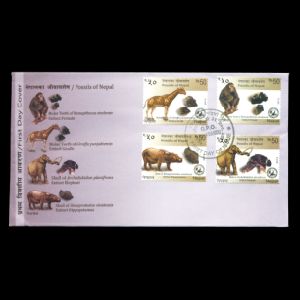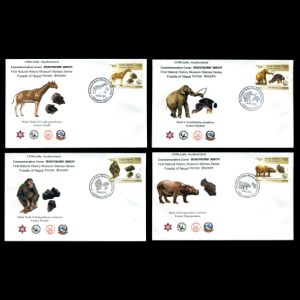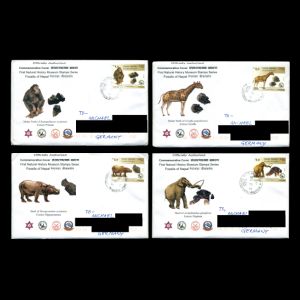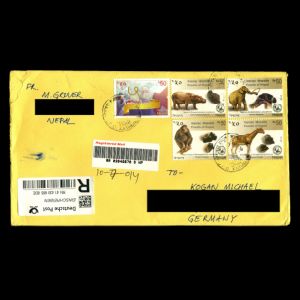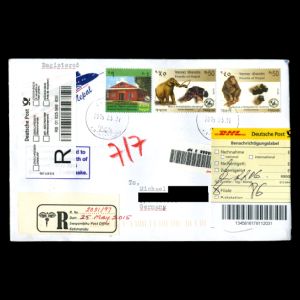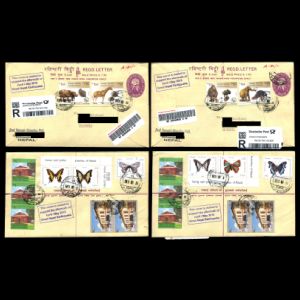Nepal 2013 "Fossils of Nepal"
| << previous page | back to index | next page >> |
| Issue Date | 31.12.2013 |
| ID | Michel: 1121-1124; Scott: 942-945; Stanley Gibbons: 1143-1146; Yvert et Tellier: 1079-1082; Category: pR |
| Design |
Illustrations: Mr. Rajman Man Maharjan, the artist of the Natural History Museum of Nepal Stamps Design: Mr. Purna Kala Limbu Consultant: Dr. Ramesh Shrestha, Chief of Natural History Museum of Nepal |
| Stamps in set | 4 |
| Value |
Rs. 50.00 - Giraffa punjabiensis (Extinct Giraffe) Rs. 50.00 - Archidiskidon planifrons (Extinct Elephant) Rs. 50.00 - Ramapithecus sivalensis (Extinct Primate) Rs. 50.00 - Hexaprotodon sivalensis (Extinct Hippopotamus) |
| Emission/Type | commemorative |
| Issue place | Kathmandu |
| Size (width x height) | 42.5 mm x 31.5 mm |
| Layout | 40 stamps per sheet |
| Products | FDC x 1, PC x4 |
| Paper | Security Stamp paper UV dull with visible & invisible fibers & phosphorescent dots. |
| Perforation | 13 x 13.25 |
| Print Technique | Offset Lithography |
| Printed by | |
| Quantity | 500.000 each |
| Issuing Authority | His Majesty's Government of Nepal Postal Services Department |
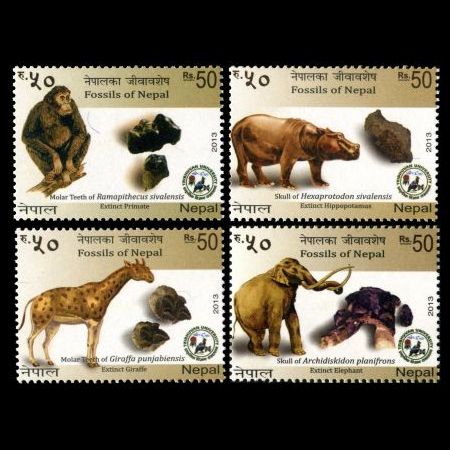
On December 31st, 2013, the Post Authority of Nepal announced the set of 4 stamps "Fossils of Nepal" showing some fossils and reconstructions of prehistoric animals who lived on the territory of the country in the past.
These stamps are declared on this day, but arrived at the post offices of Nepal much later, as they were printed abroad, in Spring 2014, even though FDC were cancelled with postmark dated 31.12.2013. The Natural History Museum of Nepal issued their commemorative covers, cancelled on May 18th, 2014, in GPO of Kathmandu.
Fossils of these animals were discovered in various areas of Nepal and are in the collection of the Natural History Museum of Nepal. Dr. Ramesh Shrestha, Chief of the Natural History Museum worked closely with the designer of the stamps and Nepal's Post Authority to create these stamps. |
Dr. Ramesh Shrestha was appointed as Chief of the Natural History Museum
under the Institute of Science and Technology (IOST) in June 2013.
Previously Dr. Shrestha worked at the Central Department of Zoology in Kirtipur,
for more than two decades, where he taught Evolutionary Biology,
Biogeography and Climatology.
Dr. Shrestha saw the huge collection of natural objects at the museum and
determined that there was great potential to do a lot of work and research.
He also wanted popularize the study of Natural history by young people in Nepal,
therefore he came up with the idea to issue some postage stamps showing objects
(not only fossils) from the collection of the museum.
Rajman Man Maharjan, the artist of the museum created
sketches
with reconstructions of prehistoric animals, based on fossils from the collection
of the museum.
Four sketches were sent by Dr. Shrestha to the Postal Service Department of Nepal with
the request to use the logo of the Natural History Museum on every stamp.
On May 18th, 2014, to commemorate the issue, the Natural History Museum organized a special event "First Natural History Museum Stamps: Fossils of Nepal". Many honourable guests from the Institute of Science and Technology and the Postal Administration attended. During this event the museum presented their commemorative covers cancelled with unique postmarks.
Several stamp series, which show various objects from the Museum collection, were issued in the following years.
These stamps were printed on Security Stamp paper UV dull with visible & invisible fibers & phosphorescent dots.
The Natural History Museum of Nepal is situated on the lap of Swayambhu Stupa, a world heritage site in the west hillock of Kathmandu Valley. Swayambhu Hillock is itself a famous place not only in the context of the culture, religion and history of Kathmandu valley, but also equally famous place for the early plant hunters in Nepal.
 |
The museum was established in 1975. Since then, the museum has collected 50.000 specimens of Nepal’s modern and prehistoric flora and fauna. The museum also have some relics from the country's prehistoric times. There is a fossilized skull of the Archidiskodon, a species of elephant that roamed the Sivalik Hills of Nepal. Another ancient specimen is the molar teeth of Sivapithecus, a hominoid. The skull and the teeth are believed to be around 3 million years and 8-10 million years old respectively. Fossils of all animals are depicting on stamps bellow are from collection of the museum.
The text below is based on the information printed in the flyer attached to official FDC and the reverse side of commemorative covers issued by the Natural History Museum of Nepal, written by Dr. Ramesh Shrestha, Chief of the Natural History Museum.
Extinct Giraffe - Giraffa punjabiensis
The stamp show reconstruction of the giraffe and its molar teeth, estimated 2.5 million years ago, from the collection of the Natural History Museum.
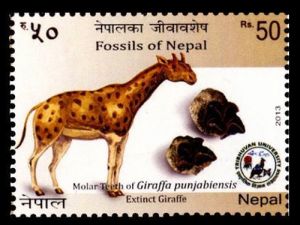 |
| Giraffa punjabiensis, extinct Giraffe on stamp of Nepal 2013, MiNr.: 1123, Scott: 940. |
The extinct Giraffa punjabiensis inhabited large parts of Eurasia including the ancient land of Nepal and eventually spread into Africa. Fossil records indicate many other giraffids thrived between the Miocene Era (around 20 million years ago) and the recent past.
They formed part of a relatively late mammal diversification that also produced cattle, antelopes, and deer following a climate change that transformed subtropical woodlands into open savannah grasslands.
The descendants of the Giraffa punjabiensis species form parts of a relatively late mammal diversification that also produced cattle, antelopes, and deer following a climate change that transformed subtropical woodlands into open ruminant artiodactyls mammals that share a common ancestor with deer and bovid.
The biological family, once a diverse group spread throughout Eurasia and Africa, contains only two living members, the giraffe and the okapi.
The molar teeth of this extinct Giraffe were found at the Surai Khola Formation in Nepal.
Extinct Elephant - Archidiskidon planifrons
The stamp show reconstruction of the elephant and its skull with partial tusks and teeth, estimated 3 million years ago, from the collection of the Natural History Museum.
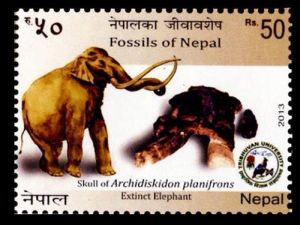 |
| Archidiskidon planifrons, extinct Giraffe on stamp of Nepal 2013, MiNr.: 1122, Scott: 943. |
While tracing the biogeography of these animals they were found to live in large parts of Asia during the Pleistocene, Pliocene and the Holocene epochs.
Interestingly, these animals were also found in the then ancient lands of present day Nepal. Like their modern relatives, Archidiskidon were quite large.
The largest known species reached height in the region of 4 meters at the shoulder and weighed up to 8 tones, while exceptionally large males may have exceeded 12 tones. However, most species of Archidiskidon were only about as large as a modern Asia elephant (which are about 2.5 meters to 3 meters high at the shoulder).
Both sexes of Archidiskidon bore tusks. A definitive explanation for their extinction has yet to be agreed upon. The warming trend (Holocene) that occurred 12,000 years ago could have contributed to their process of extinction. Many forests replaced open woodlands and grasslands also, which contributed in the reduction of their habitats.
Many fossilized body parts of these elephants were recorded from different parts of Nepal. There is a fossilized skull of the Archidiskidon were discovered on the banks of Ratua Khola river in the collection of Natural History Museum. The present stamp shows the image of Archidiskidon planifrons and the completed skull with its tusks.
Extinct Primate - Ramapithecus sivalensis
The stamp show reconstruction of the primate and its molar teeth, estimated 9.0-9.5 million years ago, from the collection of the Natural History Museum.
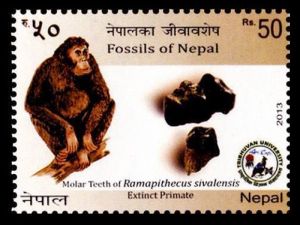 |
 |
| Ramapithecus sivalensis, extinct Giraffe on stamp of Nepal 2013, MiNr.: 1124, Scott: 941. The stamp on the right has a perforation error. | |
During that time it was claimed that the jaw was more like a human jaw.
Ramapithecus was understood to have direct ancestral roots to modern humans. Meanwhile, more complete specimens of Ramapithecus were found in 1975 and 1976, which showed that it was less human-like than had been thought before. It began to look more and more like better Sivapithecus instead of Ramapithecus. The analysis of the original Ramapithecus fossils had errors directing them as ancestors of modern humans.
In 1982, David Pilbeam published a description of a significant fossil find if a large part of the face and jaw of Sivapithecus. This specimen bore many similarities to the Orang-utan skull and with the help of more modern tools, it strengthened the theory of Sivapithecus (Ramapithecus) being closely related to Orang-utan than human beings.
Today it is believed that the fossils attributed to Ramapithecus actually represent the slightly smaller females of Sivapithecus. So, neither Ramapithecus nor Sivapithecus was direct Homo sapiens (present day human beings) ancestor.
Extinct Hippopotamus - Hexaprotodon sivalensis
The stamp show reconstruction of the hippopotamus and it's complete skull and lower jaws, estimated 9.0-9.5 million years ago, from the collection of the Natural History Museum.
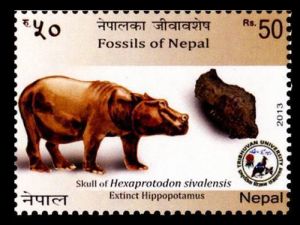 |
| Hexaprotodon sivalensis, extinct Giraffe on stamp of Nepal 2013, MiNr.: 1121, Scott: 942. |
It lived during the Pliocene and the Pleistocene (5.33 to 0.11 million years ago). Fossils of this species have been found in Indonesia, India, Sri Lanka, and Nepal.
It was obviously a very widely distributed creature. The height of Hexaprotodon is estimated to have been about 75 cm. and it is thought to have weight around 180 kg. The size of Hexaprotodon was comparable to that of the living pygmy hippopotamus of Madagascar.
There are few species of Hippos that have become extinct over time. It is believed that they were around until about 1,000 years ago. The overall size of them was smaller than the Hippos we are familiar with today. It is believed that they were smaller as a way of surviving in their environment.
The European Hippo is also extinct but it was once found throughout Europe as well as the British Isles. It is believed that they became extinct before the last glaciations period. These Hippos were much larger than those we know about today.
In Nepal the fossils of Hexaprotodon sivalensis have been discovered at Gidniya Village and Rato Khola.
The skull and lower jaw of this extinct hippopotamus is one of the appealing items in the collection of Natural History Museum. The present stamp shows the image of Hexaprotodon sivalensis and the complete skull and lower jaws.
Related stamps
| "Natural History Museum of Nepal" | "Prehistoric elephants of Nepal" | "Prehistoric mammals of Nepal" |
 |
 |
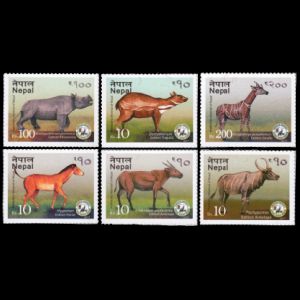 |
Products and associated philatelic items
| Commemorative Postmarks associated with the stamps, used on the commemorative covers of the Natural History Museum of Nepal | |||
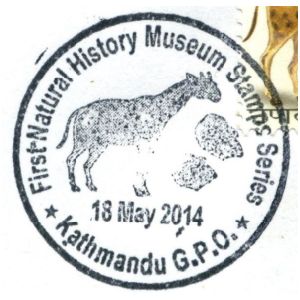 |
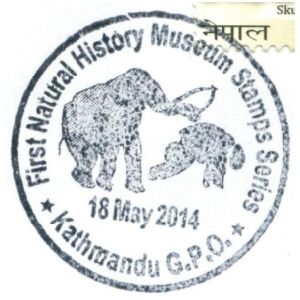 |
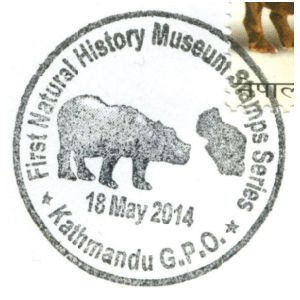 |
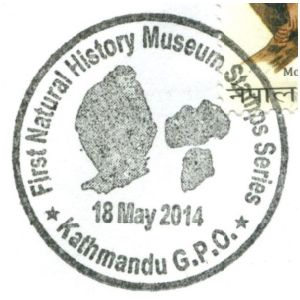 |

|
 |
References
-
Technical details and short description of the stamps:
-
The Natural History Museum of Nepal:
-
Description of prehistoric animals depicted on the stamps:
- Inside text of FDC
- Reverse side of commemorative covers of the Natural History Museum
- Book "Prehistoric Mammals of Nepal", by Prof. Ramesh Shresta, published in 2015 in Nepal. ISBN: 978-9937-2-9672-4
Acknowledgements
- Many thanks to Dr. Peter Voice from Department of Geological and Environmental Sciences, Western Michigan University, for reviewing the draft page and his valuable comments.
- Many thanks to Mr. Shankar Shrestha and Dr. Ramesh Shrestha for their support.
| << previous page | back to index | next page >> |

